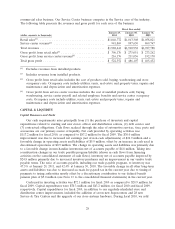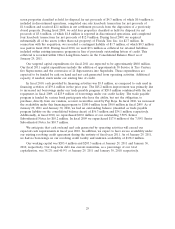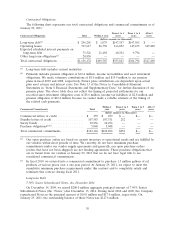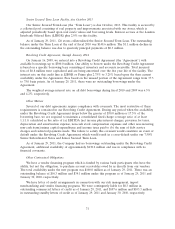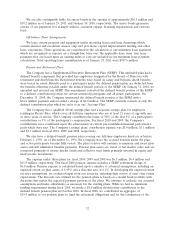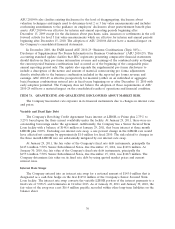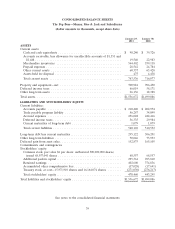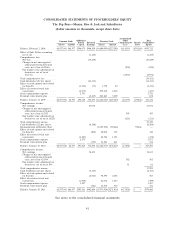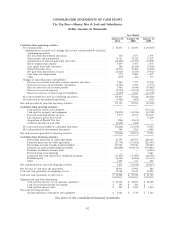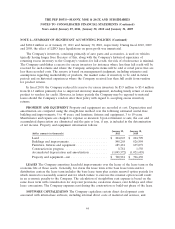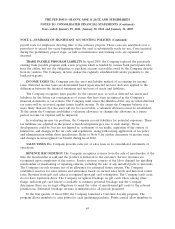Pep Boys 2010 Annual Report Download - page 93
Download and view the complete annual report
Please find page 93 of the 2010 Pep Boys annual report below. You can navigate through the pages in the report by either clicking on the pages listed below, or by using the keyword search tool below to find specific information within the annual report.effect. Legislation changes currently proposed by certain states in which we operate, if enacted,
could increase our transactions or activities subject to tax. Any such legislation that becomes law
could result in an increase in our state income tax expense and our state income taxes paid,
which could have a material effect on our net earnings.
At any one time our tax returns for many tax years are subject to examination by U.S. Federal,
commonwealth, and state taxing jurisdictions. For income tax benefits related to uncertain tax
positions to be recognized, a tax position must be more-likely-than-not to be sustained upon
examination by taxing authorities. The amount recognized is measured as the largest amount of
benefit that is greater than 50 percent likely of being realized upon ultimate settlement. An
uncertain income tax position will not be recognized in the financial statements unless it is
more-likely-than-not to be sustained. We adjust these tax liabilities, as well as the related interest
and penalties, based on the latest facts and circumstances, including recently published rulings,
court cases, and outcomes of tax audits. To the extent our actual tax liability differs from our
established tax liabilities for unrecognized tax benefits, our effective tax rate may be materially
impacted. While it is often difficult to predict the final outcome of, the timing of, or the tax
treatment of any particular tax position or deduction, we believe that our tax balances reflect the
more-likely-than-not outcome of known tax contingencies.
The temporary differences between the book and tax treatment of income and expenses result in
deferred tax assets and liabilities, which are included within our consolidated balance sheets. We
must then assess the likelihood that our deferred tax assets will be recovered from future taxable
income. To the extent we believe that recovery is not more-likely-than-not, we must establish a
valuation allowance. To the extent we establish a valuation allowance or change the allowance in
a future period, income tax expense will be impacted. Actual results could differ from this
assessment if adequate taxable income is not generated in future periods from either operations
or projected tax planning strategies. We had net deferred tax assets of $9.7 million at
January 29, 2011.
RECENT ACCOUNTING STANDARDS
In March 2007, the FASB issued guidance on accounting for split dollar life insurance
arrangements which was included in ASC 718 ‘‘Compensation—Stock Compensation.’’ This ASC
provides guidance on determining whether a liability for the postretirement benefit associated with a
collateral assignment split-dollar life insurance arrangement should be recorded. ASC 718 also provides
guidance on how a company should recognize and measure the asset in a collateral assignment split-
dollar life insurance contract. The original guidance for accounting for split dollar life insurance
arrangements was effective for fiscal years beginning after December 15, 2007. The adoption of ASC
718 resulted in a $1.2 million net of tax charge to retained earnings on February 3, 2008.
In October 2009, the FASB issued Accounting Standards Update (‘‘ASU’’) 2009-13 ‘‘Revenue
Recognition (Topic 605)—Multiple-Deliverable Revenue Arrangements a consensus of the FASB
Emerging Issues Task Force,’’ (‘‘ASU 2009-13’’). This update eliminates the residual method of
allocation and requires that consideration be allocated to all deliverables using the relative selling price
method. ASU 2009-13 is effective for material revenue arrangements entered into or materially
modified in fiscal years beginning on or after June 15, 2010. The adoption of ASU 2009-13 did not
have a material impact on the consolidated financial statements.
In January 2010, the FASB issued ASU 2010-06 ‘‘Fair Value Measurements—Improving
Disclosures on Fair Value Measurements’’ (‘‘ASU 2010-06’’). This guidance requires new disclosures
surrounding transfers in and out of level 1 or 2 in the fair value hierarchy and also requires that the
reconciliation of level 3 inputs includes separately reported information on purchases, sales, issuances
and settlements. The increased disclosures should be reported for each class of assets or liabilities.
35





